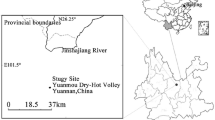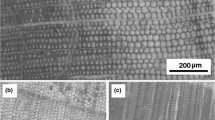Abstract
-
• Knowledge of whole tree seedling water fluxes is important in ecological and forestry research, especially under conditions with low transpiration, but no standard method has yet been established that provides reliable in situ measurements.
-
• The aims were: (1) to assess the performance of two methods for estimating sap-flows in oak seedlings following planting by correlating the data they provided with natural light intensities over a three-week period, and (2) to compare the estimates with transpiration data obtained by weighing pots.
-
• Estimates of sap flows obtained from data provided by constant power (Dayau-type) heat balance gauges under low light conditions (100–450 μmol m−2 s−1) were less variable than estimates from variable power (EMS-type) heat balance gauges. The EMS-type system yielded data with little between-gauge variation, but consistently underestimated transpiration on a daily basis, a systematic error that should be corrected by other methods. The Dayau-type gauges yielded data with substantial variations, and several gauges are probably needed in research to cover these variations. Further, both systems provide rather uncertain estimates of short-time (hour) transpiration rates.
-
• However, provided that these considerations are taken into account, we conclude that it should be possible to use either system in various research contexts.
Résumé
-
• La connaissance des flux d’eau de l’arbre entier est importante dans la recherche en écologie et en foresterie, en particulier dans des conditions de faible transpiration, mais jusqu’à présent, aucune méthode standard ne procure des mesures fiables in situ.
-
• Les objectifs étaient : (1) d’évaluer la performance de deux méthodes d’estimation des flux de sève en suivant une plantation de semis de chêne et en corrélant les données fournies par ces dernières avec les intensités de lumière naturelle sur une période de trois semaines, et (2) de comparer les estimations de transpiration avec des données obtenues par pesée des pots.
-
• Les estimations de flux de sève obtenues à partir des données fournies par une alimentation constante (Dayau-type) des jauges de bilan thermique sous des conditions de faible luminosité (100–450 μmol m−2 s−1) sont moins variables que les estimations des jauges de bilan thermique à puissance variable (EMS-type). Le système EMS-type a fourni des données avec peu de variation entre les jauges, mais a toujours sous-estimé la transpiration sur une base quotidienne, une erreur systématique qui doit être corrigé par d’autres méthodes. Les jauges de type Dayau ont fourni des données avec des variations importantes, et plusieurs jauges sont probablement nécessaires pour la compréhension de ces variations. En outre, les deux systèmes fournissent des estimations plutôt incertaines des taux de transpiration pour des courtes périodes de temps (heure).
-
• Cependant, à condition que ces considérations soient prises en compte, nous concluons qu’il devrait être possible d’utiliser les deux systèmes, dans divers contextes de recherche.
Similar content being viewed by others
References
Baker J.M. and Van Bavel C.H.M., 1987. Measurement of mass flow of water in the stems of herbaceous plants. Plant Cell Environ. 10: 777–782.
Barnes A.D., 2002. Effects of phenology, water availability, and seed source on loblolly pine biomass partitioning and transpiration. Tree Physiol. 22: 733–740.
Čermák J., Jeník J., Kučera J., and Žídek V., 1984. Xylem water flow in a crack willow tree (Salix fragilis L.) in relation to diurnal changes of environment. Oecologia 64: 145–151.
Čermák J., Kučera J., and Nadezhdina N., 2004. Sap flow measurements with some thermodynamic methods, flow integration within trees and scaling up from sample trees to entire forest stands. Trees 18: 529–546.
Cienciala E. and Lindroth A., 1995. Gas-exchange and sap flow measurements of Salix viminalis trees in short-rotation forest. Trees 9: 289–294.
Coners H. and Leuschner C., 2002. In situ water absorption by tree fine roots measured in real time using miniature sap-flow gauges. Funct. Ecol. 16: 696–703.
Coners H. and Leuschner C., 2005. In situ measurement of fine root water absorption in three temperate tree species — Temporal variability and control by soil and atmospheric factors. Basic Appl. Ecol. 6: 395–405.
Dayau S., 1993. Réalisation des capteurs pour la mesure du débit de sève dans des arbres (méthode du bilan de chaleur). Cahiers Tech. INRA 31: 3–24.
De Wit C.T., 1958. Transpiration and crop yields, Institute of Biological and Chemical Research on Field Crops and Herbage, Wageningen, The Netherlands, Verlagen Landbouwkundige Onderzoekingen 64.6, 1–88.
Dugas W.A., Wallace J.S., Allen S.J., and Roberts J.M., 1993. Heat balance, porometer, and deuterium estimates of transpiration from potted trees. Agric. For. Meteorol. 64: 47–62.
Gerdes G., Allison B.E., and Pereira L.S., 1994. Overestimation of soybean crop transpiration by sap flow measurements under field conditions in central Portugal. Irrig. Sci. 14: 135–139.
Grime V.L., Morison J.I.L., and Simmonds L.P., 1995a. Including the heat storage term in sap flow measurements with the heat balance method. Agric. For. Meteorol. 74: 1–25.
Grime V.L., Morison J.I.L., and Simmonds L.P., 1995b. Sap flow measurements from stem heat balances: a comparison of constant with variable power methods. Agric. For. Meteorol. 74: 27–40.
Grime V.L. and Sinclair F.L., 1999. Sources of errors in stem heat balance sap flow measurements. Agric. For. Meteorol. 94: 103–121.
Groot A. and King K.M., 1992. Measurement of sap flow by the heat balance method: numerical analysis and application to coniferous seedlings. Agric. For. Meteorol. 59: 289–308.
Higgs K.H., 1994. Water stress and water use in broadleaved seedlings: Evaluation of sap flow gauges in water relation research. Asp. Appl. Biol. 38: 153–163.
IPCC. 2007. Climate change, 2007. Synthesis report, Cambridge University Press, Cambridge.
Ishida T., Gaylon S.C., and Calissendorff C., 1991. Improved heat balance method for determining sap flow rate. Agric. For. Meteorol. 56: 35–48.
Kjelgaard J.F., Stockle C.O., Black R.A., and Campbell G.S., 1997. Measuring sap flow with the heat balance approach using constant and variable heat inputs. Agric. For. Meteorol. 85: 239–250.
Kozlowski T.T. and Davies W.J., 1975. Control of water balance in transplanted trees. J. Arboric. 1: 1–10.
Lindroth A., Cermak J., Kucera J., Cienciala E., and Eckersten H., 1995. Sap flow by the heat balance method applied to small size Salix trees in a short-rotation forest. Biomass Bioenergy 8: 7–15.
Löf M., 2000. Establishment and growth in seedlings of Fagus sylvatica and Quercus robur: Influence of interference from herbaceous vegetation. Can. J. For. Res. 30: 855–864.
Lüttschwager D. and Remus R., 2007. Radial distribution of sap flux density in trunks of a mature beech stand. Ann. For. Sci. 64: 431–438.
Ma L., Lu P., Zhao P., Rao X.-Q., Cai X.-A., and Zeng X.-P., 2008. Diurnal, daily, seasonal and annual patterns of sap-flux-scaled transpiration from an Acacia mangium plantation in south China. Ann. For. Sci. 65: 402.
Messina M.G. and Duncan J.E., 1993. Irrigation effects on growth and water use of Quercus virginiana (Mill.) on a Texas lignite surfacemined site. Agric. Water Manage. 24: 265–280.
Pierret A., Moran C.J., and Doussan C., 2005. Conventional detection methodology is limiting our ability to understand the roles and functions of fine roots. New Phytol. 166: 967–980.
Sakuratani T., 1981. A heat balance method for measuring water flux in the stem of intact plants. J. Agric. Meteorol. 37: 9–17.
Sakuratani T., 1984. Improvement of the probe for measuring water flow rate in intact plants with the stem heat balance method. J. Agric. Meteorol. 40: 273–277.
Sands R., Fiscus E.L., and Reid C.P.P., 1982. Hydraulic properties of pine and bean roots with varying degrees of suberization, vascular differentiation and mycorrhizal infection. Aust. J. Plant. Physiol. 9: 559–569.
Senock R.S. and Ham J.M., 1995. Measurements of water use by prairie grasses with heat balance flow gauges. J. Range Manage. 48: 150–158.
Shackel K.A., Johnson R.S., and Medawar C.K., 1992. Substantial errors in estimates of sap flow using the heat balance technique on woody stems under field conditions. J. Am. Soc. Hortic. Sci. 117: 351–356.
Steinberg S.L., Van Bavel C.H.M., and McFarland M.J., 1990. Improved sap flow gauge for woody and herbaceous plants. Agron. J. 82: 851–854.
Steppe K., Lemeur R., and Dierick D., 2005. Unravelling the relationship between stem temperature and air temperature to correct for errors in sap-flow calculations using the stem heat balance sensors. Funct. Plant Biol. 32: 599–609.
Stone E.C., 1955. Poor survival and the physiological condition of planting stock. For. Sci. 1: 90–94.
Valancogne C. and Nasr Z., 1993. A heat balance method for measuring sap flow in small trees. In: Boghetti M., Grace J., and Raschi A. (Eds.), Water transport in plants under climatic stress, Cambridge University Press, Cambridge, pp. 166–173.
Weibel F.P. and de Vos J.A., 1994. Transpiration measurements on apple trees with an improved stem heat balance method. Plant and Soil 166: 203–219.
Welander N.T. and Ottosson B., 2000. The influence of low light, drought and fertilization on transpiration and growth in young seedlings of Quercus robur L. For. Ecol. Manage. 127: 139–151.
Wiltshire J.J.J., Wright C.J., Colls J.J., and Unsworth M.H., 1995. Effects of heat balance stem-flow gauges and associated silicone compound on ash trees. Agric. For. Meteorol. 73: 135–142.
Author information
Authors and Affiliations
Corresponding author
Rights and permissions
About this article
Cite this article
Löf, M., Welander, N.T. Estimating sap flow from stem heat balances in Quercus robur L. seedlings in relation to light intensity: A comparison of two methods during the establishment phase. Ann. For. Sci. 66, 501 (2009). https://doi.org/10.1051/forest/2009034
Received:
Accepted:
Issue Date:
DOI: https://doi.org/10.1051/forest/2009034




